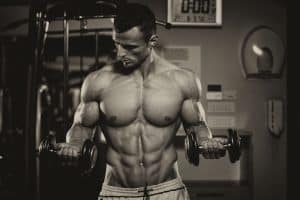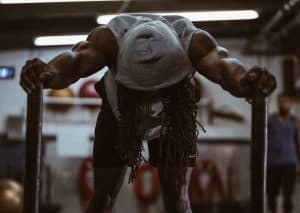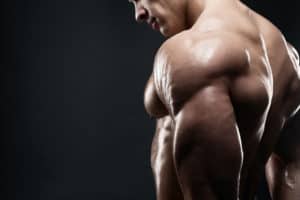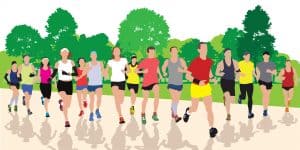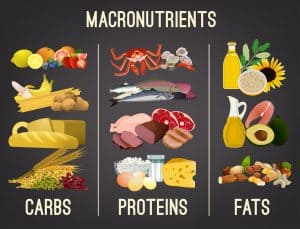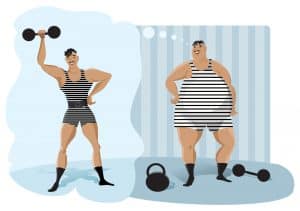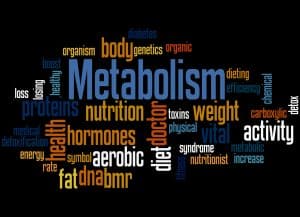The “push pull legs” routine is one of the most basic training programs that target all your muscle groups efficiently. Workout sessions consist of three movements:
Push movements: target your upper body and involves the chest, shoulder, and triceps muscles.
Pull movements: include back and biceps muscles.
Legs: target your entire lower body muscles; quads, hamstrings, glutes, and calves.
Benefits of the Push Pull Legs Workout
While considered as “boring” by many lifters (just as the upper/lower body workout split), it is without a doubt one of the most productive and beneficial workout routines.
Some of the benefits include:
- Beginners-to-advanced friendly and saves time.
- Suitable for natural bodybuilders and weightlifters.
- It groups secondary muscles in a single workout that benefits from the bigger muscle group.
For example, when you perform bench press to train your chest, your shoulders and triceps muscles are involved. When you perform standing military press to train your shoulders, your triceps are involved. - It allows for local muscle recovery by stretching the opposite muscle group: For example, when you train your back, you are stretching your chest, and when you train your triceps, you are stretching your biceps.
This way, the overlap between the trained muscle groups is minimal, allowing for frequency increment as you advance in training level. - It includes lots of compound movements and 1 repetition-maximum (1RM), which makes it favorable for strength training. With the addition of some isolation movements and manipulating the training frequency, it becomes one of the best programs for muscle hypertrophy as well as stamina.
- An upgrade from the full body workout routine.
With these benefits in mind, one of the biggest disadvantages of the push pull program is that it’s not favorable if you want to fix muscle imbalances.
As you get stronger, attempt to increase the weights, sets, to get stronger and to start seeing results faster without sacrificing the form. This is known as progressive overload.
Exercises Layout - Variation A
Here are two different variations of the push, pull, legs exercises. The selections below were made as inclusive as possible, and they are by no means exclusive. So, feel free to pick alternatives you are more comfortable with.
Push A:
Chest:
Exercise
Sets
Reps
Rest (Min.)
Flat Barbell Bench Press
4
15-6-1RM
2 - 5
Incline Dumbbell Bench Press
3
10 - 6
2 - 3
bodyweight or weighted Dips (Optional)
3
10 - 6
2 - 3
Shoulders:
Exercise
Sets
Reps
Rest (Min.)
Standing military press
3
10 - 6
2 - 3
Dumbbell lateral raises
3
15 - 10
1 - 2
Dumbbell Rear raises
3
15 - 10
1 - 2
Triceps:
Exercise
Sets
Reps
Rest (Min.)
Barbell Skull Crushers
3
12 - 8
2 - 3
Cable Push-Down
3
15 - 10
1 - 2
Pull A:
Back:
Exercise
Sets
Reps
Rest (Min.)
Deadlift
5
15-6-1RM
2 - 5
Bent Over Barbell Row
3
10 - 6
2 - 3
Barbell Shrugs (Trapezius)
3
12 - 8
1 - 2
Wide Lat Pull-Down
3
12 - 8
2 - 3
Bodyweight or weighted Pull-Ups
3
12 - 8
2 - 3
Biceps:
Exercise
Sets
Reps
Rest (Min.)
Dumbbell Bicep Curls
3
12 - 8
2 - 3
Barbell Concentration Curl
3
12 - 8
2 - 3
Dumbbell Hammer Curls (Optional)
3
12 - 8
1 - 2
Legs A:
Legs:
Exercise
Sets
Reps
Rest (Min.)
Squat
5
15 - 6
2 - 3
Leg Extension
3
12 - 8
2 - 3
Leg Curls
3
10 - 6
2 - 3
Walking Lunges
3
15 - 10
2 - 3
Standing/Seated Calf Raises
4
15 - 10
1 - 3
Abdominals:
Exercises Layout - Variation B
Here are two different variations of the “push pull legs” exercises. The selections below were made as inclusive as possible, and they are by no means exclusive. So, feel free to pick alternatives you are more comfortable with.
Push B:
Chest:
Exercise
Sets
Reps
Rest (Min.)
Flat Dumbbell Bench Press
4
15 - 6
2 - 5
Incline Barbell Bench Press
3
10 - 6
2 - 3
Bodyweight or weighted Dips (Optional)
3
10 - 6
2 - 3
Shoulders:
Exercise
Sets
Reps
Rest (Min.)
Seated Dumbbell Or Barbell Press
3
10 - 6
2 - 3
Dumbbell Lateral Raises
3
15 - 10
1 - 2
Cable Rear raises
3
15 - 10
1 - 2
Triceps:
Exercise
Sets
Reps
Rest (Min.)
Overhead Dumbbell Extension
3
12 - 8
1 - 3
Rope Push-Down
3
15 - 10
1 - 2
Pull B:
Back:
Exercise
Sets
Reps
Rest (Min.)
Sumo Deadlift
5
15-6- 1RM
2 - 5
Single-Arm Dumbbell Row
3
10 - 6
2 - 3
Dumbbell Shrugs (Trapezius)
3
12 - 8
1 - 2
Close-Grip Reversed Lat Pull-Down
3
12 - 8
2 - 3
Bodyweight or weighted Pull-Ups
3
12 - 8
2 - 3
Biceps:
Exercise
Sets
Reps
Rest (Min.)
Barbell Bicep Curls
3
12 - 8
2 - 3
Dumbbell Concentration Curl
3
12 - 8
2 - 3
Barbell Reversed Curls
3
12 - 8
1 - 2
Legs B:
Legs:
Exercise
Sets
Reps
Rest (Min.)
Leg Presses
5
15 - 6
2 - 3
Leg Extension
3
12 - 8
2 - 3
Leg Curls
3
10 - 6
2 - 3
Walking Lunges
3
15 - 10
2 - 3
Standing/Seated Calf Raises
4
15 - 10
1 - 3
Abdominals:
As you see, the two variations above consist of basic compound movements and a few isolation movements. Moreover, these variations include a combination of barbell and dumbbell workouts.
For example, on one pull-day, you do a flat barbell bench press and incline dumbbell press. The next pull day, you reverse; you do flat dumbbell presses and incline barbell presses.
You also notice that I included trapezius shrugs in the pull days after the back rowing movement. This is because traps are an integral part of the back anatomy. Including traps training during the back movement will ensure that your traps benefit from the blood in the nearby lats and mid-back. Traps are what give you the diamond-shape back!
For legs day, I like to alternate between squat (either regular or front) and leg presses. This is because squats can exhaust the aerobic system fast due to the up and down movement of the entire body.
Finally, I like to finish off with two abdominals exercises of choice. This way, we make sure we include every muscle group in the body from forearms to calves to abs.
Below, I put together a 3-4-5-and-6 day weekly “push pull legs” training program based on variations A and B above depending on your level. Let’s get to it:
3 Day Beginners "push pull legs" Program
This push pull legs program is a 3-day workout split that is beginners-friendly. You train the upper body and the lower body once a week. You take 1 day off after the pull and push days, and 2 days off after the legs day. Then you repeat the training cycle with variation B of the movements.
week
Day 1
Day 2
Day 3
Day 4
Day 5
Day 6
Day 7
week 1
Push A
Off
Pull A
Off
Legs A
Off
Off
week 2
Push B
Off
Pull B
Off
Legs B
Off
Off
week 3
Repeat
4 Day Intermediate "push pull legs" Program:
This is a 4 day a week workout split Intermediate program. The idea here is to train your lower body once a week, and the upper body twice a week. Each week you either train pull movements or push movements twice but with both variations A and B. There are two days off at the end of the training week, so you get plenty of rest and recovery.
week
Day 1
Day 2
Day 3
Day 4
Day 5
Day 6
Day 7
week 1
Push A
Pull A
Off
Legs A
Push B
Off
Off
week 2
Pull B
Push A
Off
Legs B
Pull B
Off
Off
week 3
Repeat
Here is another variation of the 4 day “push pull legs” program you might want to try out. In this variation you train 1 day and take the following day off, but bridge day 7 and day 1 of the following week. After one training cycle with variation A, you switch to variation B, and so on.
week
Day 1
Day 2
Day 3
Day 4
Day 5
Day 6
Day 7
week 1
Push A
Off
Pull A
Off
Legs A
Off
Push B
week 2
Pull B
Off
Legs B
Off
Push A
Off
Pull A
week 3
Legs A
Off
Push B
Off
Pull B
Off
Legs B
week 4
Repeat
5 Day Advanced "push pull legs" Program:
This is a 5 day “push pull legs” program for advanced trainees. The idea here is to repeat two movement out of the three twice a week with variations A and B. So week 1 will have two push and pull days, and one legs day. Week 2 will have two leg and push days and one pull day. Week 3 will have two days off, two pull days, and one legs and push day only. And So on.
week
Day 1
Day 2
Day 3
Day 4
Day 5
Day 6
Day 7
week 1
Push A
Pull A
Off
Legs A
Push B
Off
Pull B
week 2
Legs B
Off
Push A
Pull A
Off
Legs A
Push B
week 3
Off
Pull B
Legs B
Off
Push A
Pull A
Off
week 4
Repeat
6 Day Advanced "push pull legs" Program:
This is an advanced 6 day a week “push pull legs” program. 3 days on followed by 1 day off. Think of it as training your full body once, followed by a day off.
week
Day 1
Day 2
Day 3
Day 4
Day 5
Day 6
Day 7
week 1
Push A
Pull A
Legs A
Off
Push B
Pull B
Legs B
week 2
Off
Push A
Pull A
Legs A
Off
Push B
Pull B
week 3
Legs B
Off
Repeat
Here is an intense variation of the 6 day program you might want to try out. The day off is comes after you train your full body twice in a row.
week
Day 1
Day 2
Day 3
Day 4
Day 5
Day 6
Day 7
week 1
Push A
Pull A
Legs A
Push B
Pull B
Legs B
Off
week 2
Repeat
There are a few things to consider when embarking on such high-frequency training:
- You have to fully recover before training the muscle group: If you cannot recover at the desired rate, you might end up in a continual state of muscle fiber damage and lose muscle, or you might easily get injured.
- Do not train to failure: Otherwise, you will have a very hard time recovering. It is OK to train to failure one or two sets only, but no more than that. Or you can do 1RM once say every 3-4 weeks, but not sooner than that.
- Do not stay on the program too long: You might be risking overtraining and catabolism. Use this program no more than 4 to 6 weeks. Then, scale back the frequency to 4 days a week to start seeing the results of the program.
Push Pull Legs: Final Remarks
Whether you are a beginner, intermediate, or advanced I strongly recommend you try out these “push pull legs” programs yourself and experiment with the different exercises and frequencies. Find out which program fits your fitness goals and schedule the most. Only you can determine the pros and cons of each program and each variation.
Finally, it goes without saying that eating the right amount and type of foods, consuming the necessary supplements, and recovering are the other pillars to this (or any) fitness program.


